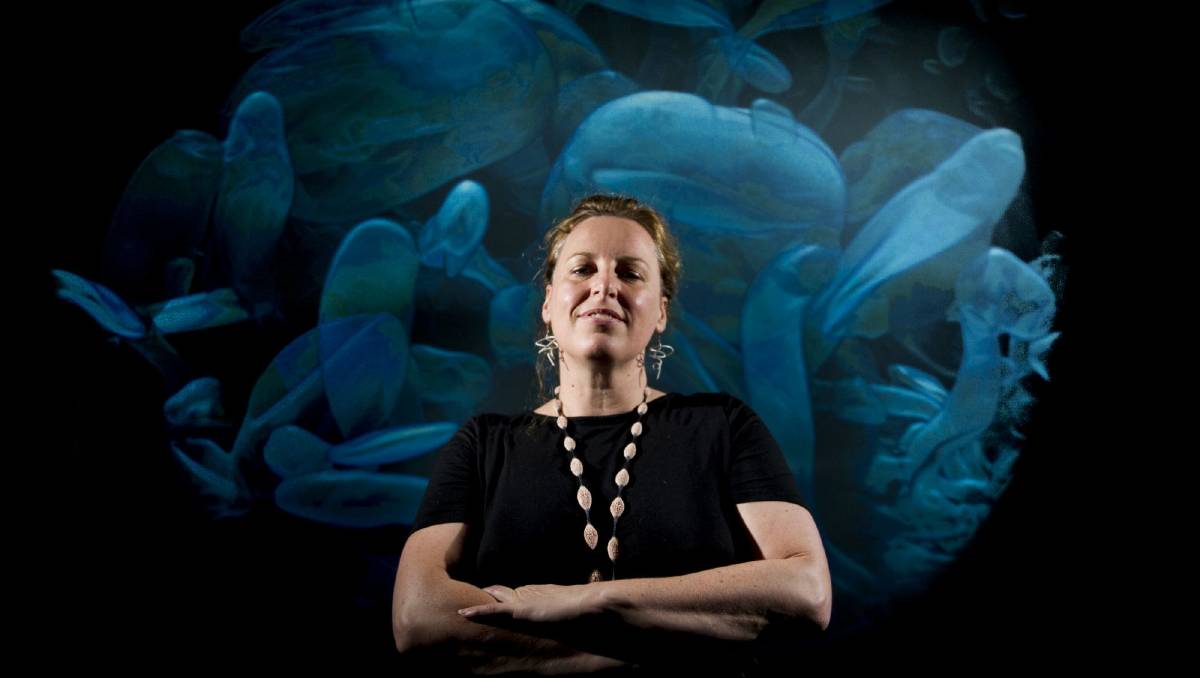
Erica Seccombe in front of Out of Season, stereoscopic projection installation. Photograph Jay Cronan, Canberra Times, 2015
ANAT Alumnus :: Erica Seccombe
ANAT ALUMNUS :: DR ERICA SECCOMBE is a visual artist based in the Canberra region, living in semi-rural NSW. Erica’s interdisciplinary arts practice spans traditional lens-based imaging, print media and drawing, to experimental digital platforms using frontier scientific visualisation software. A continuing theme arising in her work is the complex human relationships we have with nature and our natural environments, whether through social, cultural, or technological factors.
Erica has a long association with ANAT, beginning as an ANAT Synapse resident in 2010. Working with the Department of Applied Mathematics, Australian National University (ANU), a complementary focus on the visualisation and animation of complex datasets contributed to her long-term research project looking at the influence of scientific technology on visual media and contemporary art. After her ANAT Synapse residency Erica continued to investigate GROW: visualising nature at nanoscale, as a PhD candidate at the ANU School of Art Photography and Digital Media Workshop in collaboration with Professor Tim Senden and the team at the Department of Applied Mathematics. The premise behind Erica’s proposal capturing the germination of economic seeds – such as mung bean, corn, sunflower, soy and wheat – stems from her interest in agricultural philosophy and the issues raised about our future in the era of genetic modification.
2010 ANAT Synapse Residency
ERICA SECCOMBE + DEPARTMENT OF APPLIED MATHEMATICS, AUSTRALIAN NATIONAL UNIVERSITY
Read Erica’s ANAT Synapse blog here
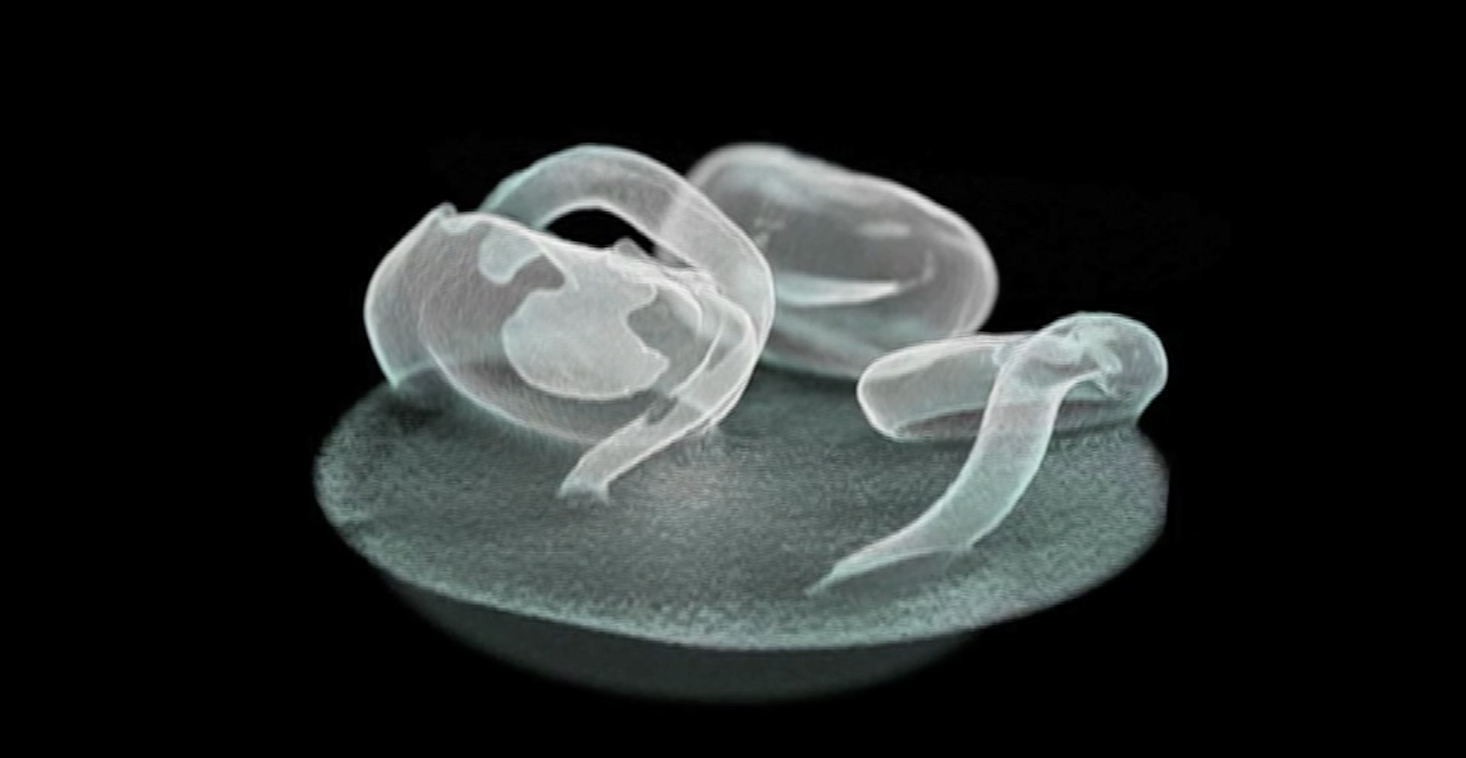
Erica Seccombe, Grow visualising nature at nanoscale (still), 2010-2017, practice-led research, 4D + 3D micro CT.
Three years later Grow featured in the exhibition 2013 Synapse: A Selection Exhibition presented by ISEA2013 and ANAT at the Powerhouse Museum. For the past decade the ANAT Synapse initiative had provided over thirty Australian artists with the opportunity to pursue speculative creative research projects with scientists and medical researchers in Australia and beyond. This exhibition provided a snapshot of the diverse and fascinating research that participating artists and scientists have pursued over the past five years. 2013 Synapse: A Selection Exhibition also featured Keith Armstrong + Kay Lawrence, Kirsty Boyle, Peta Clancy + Helen Pynor, Nola Farman, Chris Henschke, George Poonkin Khut and Ken + Julia Yonetani.
An extension of the project, the 2016 stereoscopic projection installation Out of Season used frontier scientific technologies to capture a unique view of mung beans and alfalfa seeds sprouting. The mesmerising work was created to incorporate her use of science and technology to pose new questions, and contribute to relevant contemporary art discourses and environmental concerns. Researching agricultural seeds she X-rayed in the laboratories, led Erica to consider the impact of plant extinction, global food security issues and the concept of the anthropocene in relation to her practice. Out of Season was shown at The Art and Consequence of Collaboration at ANAT SPECTRA 2018 in Adelaide, as well as starring in ANAT’s 2019 website relaunch. Erica says ‘I have been driven by the need to express through my practice, a response to the now’. Her research and artistic practice she says ‘reflects the questions, concerns and themes relevant to my lifetime. I live in a techno-scientific society in an era of rapid environmental change.’
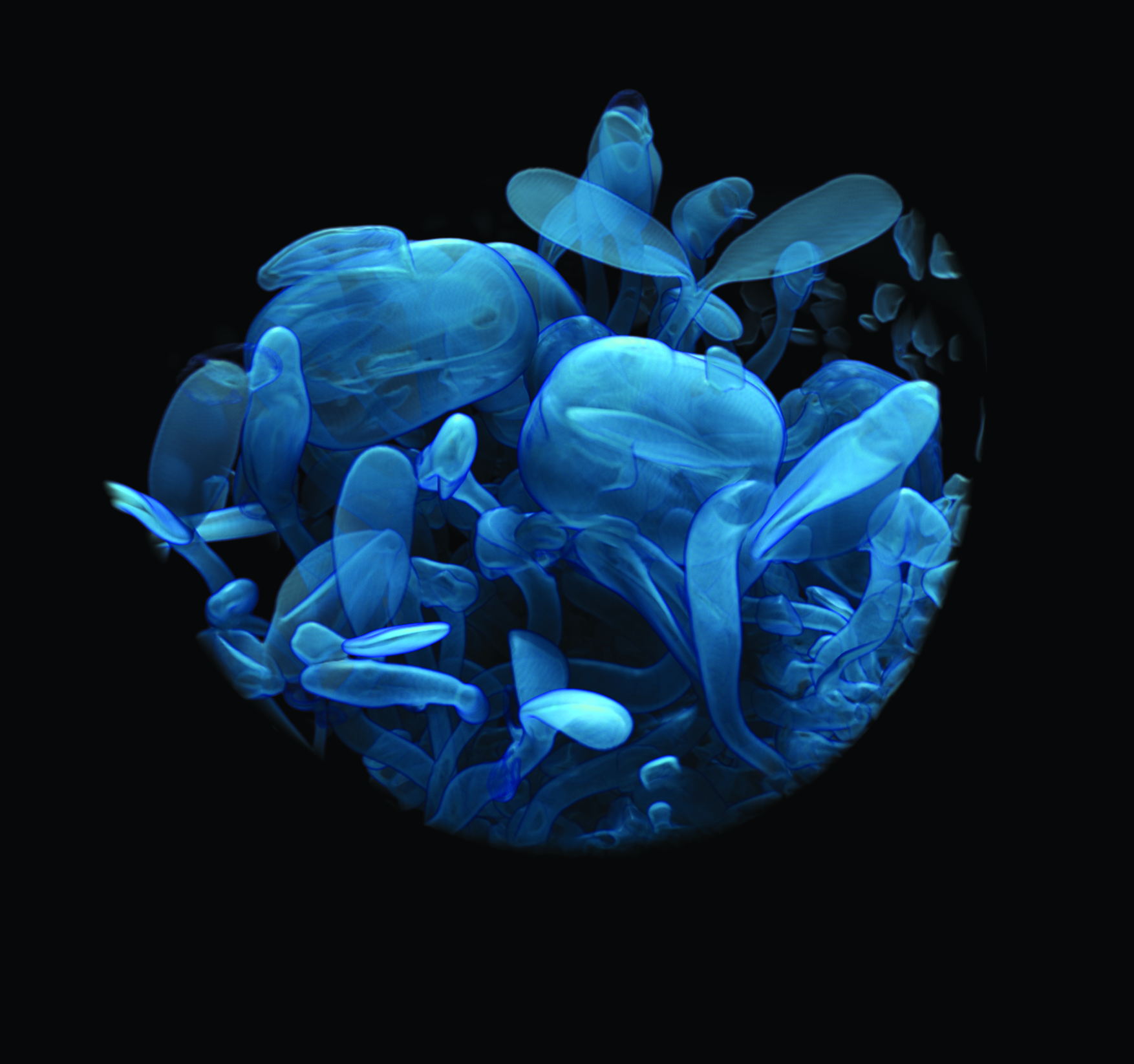
Erica Seccombe, Out of Season (still), 2016, Single channel projection, 2 minutes 40 seconds. Dimensions variable, ANU Department of Applied Mathematics, VizLab, National Computational Infrastructure, artACT project grant, Synapse residency, ANAT
In Metamorphosis 2016-2017, Erica explored one of the great mysteries of life though the transformation of fly larvae. Maggots are more commonly associated with death and decay, but like caterpillars they undergo a stage of transition before emerging as exquisite insects. In this active stereoscopic projection installation, Erica visualised and animated virtual pupa data captured through the science of 3D Microcomputed X-ray Tomography led by forensic research at the Natural History Museum in London. The work was the result of her collaborative relationship with key researchers in visualising 3D and 4D data captured with Micro-CT at the NHM Imaging and Analysis Centre. Metamorphosis was the winner of the 2018 Waterhouse Natural Science Art Prize, South Australian Museum (SAM). Judges were impressed by Erica’s work for its depiction of an ‘ordinarily unseen intersection between science and art’.
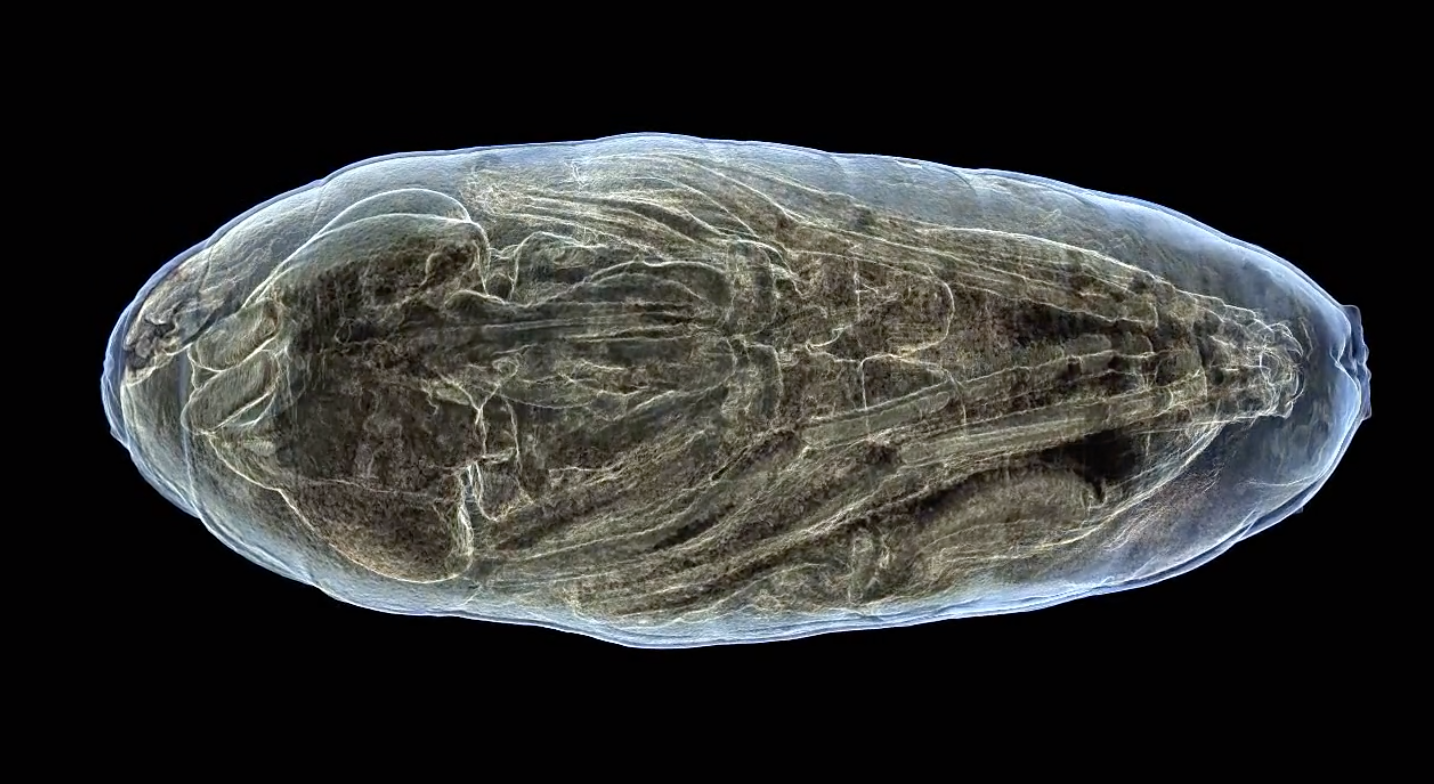
Erica Seccombe, Metamorphosis (still), 2016, single file from active stereoscopic projection installation. Pupa development at 15 degrees Celsius. 9 datasets from 10% to 100% growth 3D Micro CT. Imaging and Analysis Centre (IAC), NHM, London, Visualised and animated in Drishti by Erica Seccombe .
In 2019’s BIG PINK Erica explored the saturated colour and the extravagant geometric structure and perfection of a common Dahlia. This multi-petalled variety has been derived through centuries of genetic manipulation to create an appealing and aesthetically perfect flower. ‘The film’ Erica says is ‘an optical illusion, a virtual flower rotates in the space before us and is reflected in the prints. The mirrors and film enhance the virtual experience of this work, but the Dahlia we see here is a virtual object in the true sense of the word. The flower is not mesh-framed, instead I have used 3D micro-CT scanning to acquire volumetric datasets from a living flower.’ We’re delighted the radiant anaglyph BIG PINK is the new star of the ANAT website.
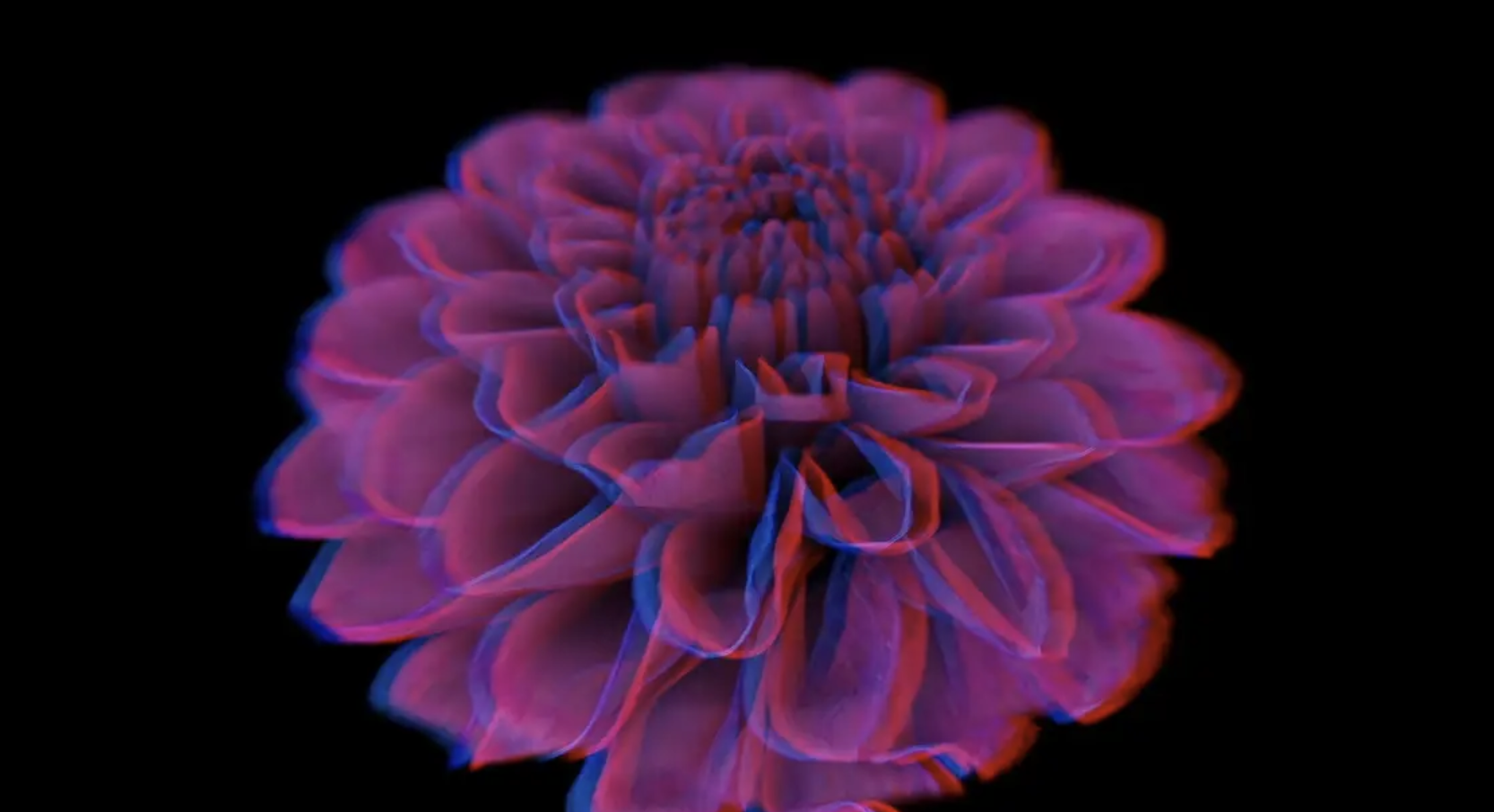
Erica Seccombe, BIG PINK (still), 2019, 3 min (looped), Single channel anaglyph 3D movie, to be viewed with red/cyan glasses. This work was created for the exhibition BIG PINK, 2019, Galerie Pompom.
Erica has been an ANAT Board Member since June 2018. The new knowledge Erica’s research has generated has had a far-reaching impact in the sciences as her research pushes the boundaries of interdisciplinary thinking, particularly in biology. She has shared her knowledge by training numerous honours, HDR students and post-doctoral researchers from medicine, physics, palaeontology, biology, forensics and geology and the visual arts. She is currently a senior lecturer at the ANU School of Art & Design, undertaking the role of Head of Foundation Studies, Convener of Graduate Studies Coursework for Visual Arts, Design and Art History and Curatorship, and teaches for The Centre for Art History and Art Theory.
ANAT Synapse Residencies 2021 | 2020 | 2019 | 2018 | 2017 | 2016 | OLDER
ANAT’s prestigious flagship program has supported creative research collaborations between more than one hundred artists and scientists, since it was established in 2004. The ANAT Synapse program is made possible through the generous support of the Copyright Agency’s Cultural Fund.